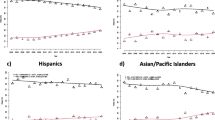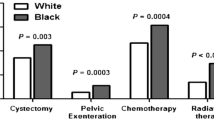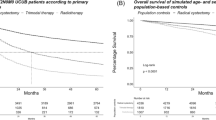Abstract
Purpose
to compare observed overall survival vs age-adjusted lifetable (LT) derived life expectancy (LE) in metastatic urothelial bladder cancer (MBCa) patients according to race/ethnicity.
Methods
We identified Caucasian, African American, Hispanic/Latino and Asian metastatic urothelial bladder cancer patients from 2004 to 2011 within the Surveillance, Epidemiology and End Results database. Social Security Administration tables were used to compute 5 year LE. LT-derived LE was compared to observed overall survival OS. Additionally, we relied on Poisson regression plots to display cancer-specific mortality (CSM) relative to other-cause mortality (OCM) for each race/ethnicity.
Results
Overall, 2286 MBCa patients were identified. Of those, 1800 (79%) were Caucasian vs 212 (9.3%) African American vs 189 (8.3%) Hispanic/Latino vs 85 (3.7%) Asians. The median age at diagnosis was 71 years for Asians vs 70 for Caucasians vs 67 for Hispanic/Latinos vs 67 for African Americans. African Americans showed the biggest difference between observed OS and LT-predicted LE at five years (− 83.8%), followed by Hispanic/Latinos (− 81%), Caucasians (− 77%) and Asian patients (− 69%). In Poisson regression plots, Hispanic/Latinos displayed the highest cancer-specific mortality rate (88%), while African/Americans showed the highest other cause mortality rate (12%). Conversely, Asian patients displayed the lowest CSM rate (83%) and second lowest OCM rate (7%).
Conclusions
African Americans showed the least favorable survival profile in MBCa, despite being youngest at diagnosis. Contrarily, Asians displayed the best survival profile in MBCa, despite being oldest at diagnosis.


Similar content being viewed by others
References
Kaufman DS, Shipley WU, Feldman AS (2009) Bladder cancer. Lancet 374:239–249
Sloan FA, Yashkin AP, Akushevich I, Inman BA (2020) The cost to medicare of bladder cancer care. Eur Urol Oncol 3:515–522. https://doi.org/10.1016/j.euo.2019.01.015
Wang Y, Chang Q, Li Y (2018) Racial differences in urinary bladder cancer in the United States. Sci Rep. https://doi.org/10.1038/s41598-018-29987-2
Koll T, Fang X, Subbiah S (2012) Trends in metastatic bladder cancer incidence and prognosis by histologic subtypes. J Clin Oncol 30:322–322. https://doi.org/10.1200/jco.2012.30.5_suppl.322
Abdollah F, Gandaglia G, Thuret R et al (2013) Incidence, survival and mortality rates of stage-specific bladder cancer in United States: a trend analysis. Cancer Epidemiol 37:219–225. https://doi.org/10.1016/j.canep.2013.02.002
Hollenbeck BK, Dunn RL, Ye Z et al (2010) Racial differences in treatment and outcomes among patients with early stage bladder cancer. Cancer 116:50–56. https://doi.org/10.1002/cncr.24701
Mallin K, David KA, Carroll PR et al (2011) Transitional cell carcinoma of the bladder: racial and gender disparities in survival (1993 to 2002), stage and grade (1993 to 2007). J Urol 185:1631–1636. https://doi.org/10.1016/j.juro.2010.12.049
Bjurlin MA, Cohn MR, Freeman VL et al (2012) Ethnicity and smoking status are associated with awareness of smoking related genitourinary diseases. J Urol 188:724–728. https://doi.org/10.1016/j.juro.2012.04.110
Von der Maase H, Hansen SW, Roberts JT et al (2000) Gemcitabine and cisplatin versus methotrexate, vinblastine, doxorubicin, and cisplatin in advanced or metastatic bladder cancer: results of a large, randomized, multinational, multicenter, phase III study. J Clin Oncol 18:3068–3077. https://doi.org/10.1200/JCO.2000.18.17.3068
Alvarez-Maestro M, Chierigo F, Mantica G et al (2021) The effect of neoadjuvant chemotherapy among patients undergoing radical cystectomy for variant histology bladder cancer: a systematic review. Arab J Urol. https://doi.org/10.1080/2090598X.2021.1994230
Flaig TW, Spiess PE, Chair V, et al (2021) NCCN guidelines version 4.2021 bladder cancer
Actuarial Life Table. https://www.ssa.gov/oact/STATS/table4c6.html. Accessed 28 Jun 2021
Würnschimmel C, Wenzel M, Collà Ruvolo C et al (2021) Life expectancy in metastatic prostate cancer patients according to racial/ethnic groups. Int J Urol 28:862–869. https://doi.org/10.1111/IJU.14595
Würnschimmel C, Kachanov M, Wenzel M et al (2021) Twenty-year trends in prostate cancer stage and grade migration in a large contemporary german radical prostatectomy cohort. Prostate. https://doi.org/10.1002/pros.24181
Nocera L, Wenzel M, Collà Ruvolo C et al (2021) The effect of race/ethnicity on active treatment rates among septuagenarian or older low risk prostate cancer patients. Urol Oncol 39:785.e11-785.e17. https://doi.org/10.1016/J.UROLONC.2021.04.004
Wenzel M, Nocera L, Ruvolo CC et al (2021) Racial/ethnic disparities in tumor characteristics and treatments in favorable and unfavorable intermediate risk prostate cancer. J Urol 206:69–79. https://doi.org/10.1097/JU.0000000000001695
Würnschimmel C, Wenzel M, Chierigo F et al (2021) External beam radiotherapy and radical prostatectomy are associated with better survival in Asian prostate cancer patients. Int J Urol. https://doi.org/10.1111/IJU.14701
Würnschimmel C, Wenzel M, Wang N et al (2021) Long-term overall survival of radical prostatectomy patients is often superior to the general population: a comparison using life-table data. Prostate 81:785–793. https://doi.org/10.1002/PROS.24176
Preisser F, Bandini M, Mazzone E et al (2019) Validation of the social security administration life tables (2004–2014) in localized prostate cancer patients within the surveillance, epidemiology, and end results database. Eur Urol Focus 5:807–814. https://doi.org/10.1016/j.euf.2018.05.006
Wolbers M, Koller MT, Stel VS et al (2014) Competing risks analyses: objectives and approaches. Eur Heart J 35:2936–2941
R: The R Project for Statistical Computing. https://www.r-project.org/. Accessed 25 Mar 2021
Wang Y, Chang Q, Li Y (2018) Racial differences in urinary bladder cancer in the United States. Sci Rep 8:12521. https://doi.org/10.1038/s41598-018-29987-2
Scosyrev E, Noyes K, Feng C, Messing E (2009) Sex and racial differences in bladder cancer presentation and mortality in the US. Cancer 115:68–74. https://doi.org/10.1002/cncr.23986
Abraído-Lanza AF, Dohrenwend BP, Ng-Mak DS, Turner JB (1999) The Latino mortality paradox: a test of the “salmon bias” and healthy migrant hypotheses. Am J Public Health 89:1543. https://doi.org/10.2105/AJPH.89.10.1543
Bajorin DF, Witjes JA, Gschwend JE et al (2021) Adjuvant nivolumab versus placebo in muscle-invasive urothelial carcinoma. N Engl J Med 384:2102–2114. https://doi.org/10.1056/nejmoa2034442
Buac NP, Khusid JA, Sturgis MR et al (2022) Disparities in patient and system factors explain racial/ethnic disparities in delayed time to treatment in muscle invasive bladder cancer. Urol Oncol Semin Orig Investig. https://doi.org/10.1016/J.UROLONC.2022.02.008
Jacobs BL, Montgomery JS, Zhang Y et al (2012) Disparities in bladder cancer. Urol Oncol Semin Orig Investig 30:81–88. https://doi.org/10.1016/J.UROLONC.2011.08.011
Author information
Authors and Affiliations
Contributions
FC—conception, performance of work, interpretation of data, writing the article, had access to the data; MB—conception, performance of work, interpretation of data, writing the article, had access to the data; CW—interpretation of data, writing the article, had access to the data; RSF—interpretation of data, writing the article, had access to the data; BH—interpretation of data, writing the article, had access to the data; GS—interpretation of data, writing the article, had access to the data; BH—interpretation of data, writing the article, had access to the data; ZT—conception, performance of work, had access to the data; FS—interpretation of data, writing the article, had access to the data; MG—interpretation of data, writing the article, had access to the data; MG—interpretation of data, writing the article, had access to the data; AB—interpretation of data, writing the article, had access to the data; FM—interpretation of data, writing the article, had access to the data; FKHC—interpretation of data, writing the article, had access to the data; SFS—interpretation of data, writing the article, had access to the data; GM—interpretation of data, writing the article, had access to the data; NS—interpretation of data, writing the article, had access to the data; CT—interpretation of data, writing the article, had access to the data; PIK—conception, interpretation of data, writing the article, had access to the data.
Corresponding author
Ethics declarations
Conflict of interest
The authors declare that they have no conflicts of interest. The research was conducted in the absence of any commercial or financial relationships that could be construed as a potential conflict of interest.
Research involving human participants and/or animals
All analyses and their reporting followed the Surveillance, Epidemiology, and End Results database (SEER) reporting guidelines. Due to the anonymously coded design of the SEER database, study-specific Institutional Review Board (IRB) ethics approval was not required.
Additional information
Publisher's Note
Springer Nature remains neutral with regard to jurisdictional claims in published maps and institutional affiliations.
Supplementary Information
Below is the link to the electronic supplementary material.
11255_2022_3221_MOESM1_ESM.pdf
Supplementary file1 Kaplan-Meier curves of Caucasian (A), African American (B), Hispanic/Latino (C) and Asian (D) metastatic bladder cancer patients treated with chemotherapy comparing observed overall survival over five years within the 2004-2011 Surveillance, Epidemiology, and End Results database vs Social Security Administration life tables predicted life expectancy for the same time period (PDF 357 KB)
11255_2022_3221_MOESM2_ESM.pdf
Supplementary file2 Kaplan-Meier curves of Caucasian (A), African American (B), Hispanic/Latino (C) and Asian (D) metastatic bladder cancer patients not treated with chemotherapy comparing observed overall survival over five years within the 2004-2011 Surveillance, Epidemiology, and End Results database vs Social Security Administration life tables predicted life expectancy for the same time period (PDF 193 KB)
11255_2022_3221_MOESM3_ESM.pdf
Supplementary file3 Kaplan-Meier curves of Caucasian (A), African American (B), Hispanic/Latino (C) and Asian (D) metastatic bladder cancer patients treated with radical cystectomy comparing observed overall survival over five years within the 2004-2011 Surveillance, Epidemiology, and End Results database vs Social Security Administration life tables predicted life expectancy for the same time period (PDF 195 KB)
11255_2022_3221_MOESM4_ESM.pdf
Supplementary file4 Treated with Kaplan-Meier curves of Caucasian (A), African American (B), Hispanic/Latino (C) and Asian (D) metastatic bladder cancer not surgically treated comparing observed overall survival over five years within the 2004-2011 Surveillance, Epidemiology, and End Results database vs Social Security Administration life tables predicted life expectancy for the same time period. (PDF 190 KB)
Rights and permissions
About this article
Cite this article
Chierigo, F., Borghesi, M., Würnschimmel, C. et al. Life expectancy in metastatic urothelial bladder cancer patients according to race/ethnicity. Int Urol Nephrol 54, 1521–1527 (2022). https://doi.org/10.1007/s11255-022-03221-5
Received:
Accepted:
Published:
Issue Date:
DOI: https://doi.org/10.1007/s11255-022-03221-5




